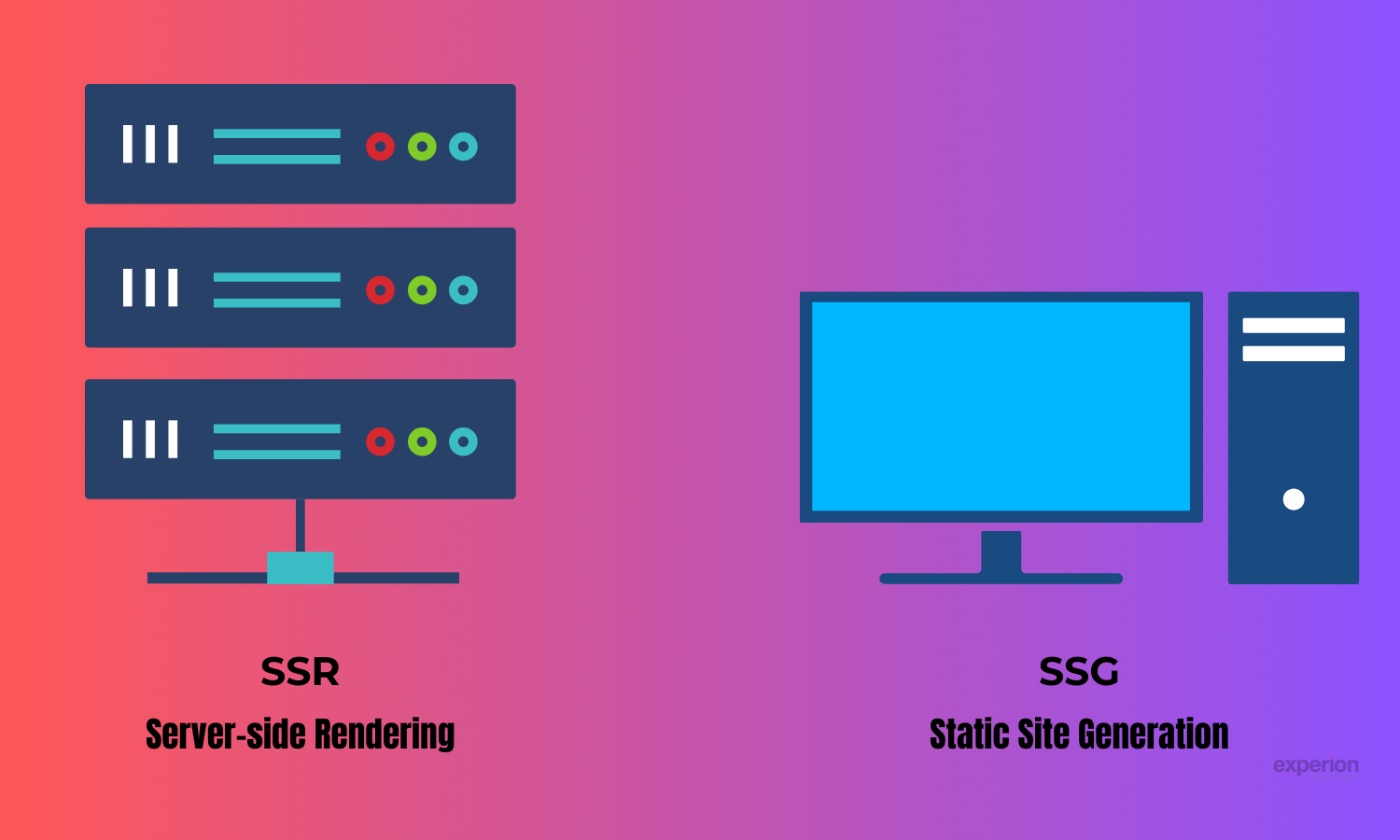This article delves into the intricate comparison between Next.js and React, shedding light on their distinct characteristics and how they synergize within the realm of web development. It navigates through their architectural disparities, conventions, configurations, and the diverse scenarios where each excels. By unravelling these fundamental differences, developers gain a comprehensive understanding of the nuanced relationship between Next.js and React, empowering them to make informed choices tailored to the requirements of their projects.
What is Next.js?
 Next.js stands out as a widely acclaimed open-source React framework, prized for its proficiency in server-side rendering (SSR), static site generation (SSG), and hybrid rendering. Crafted by the talented team at Vercel, Next.js streamlines the development journey for React applications, offering a seamless experience and an array of functionalities that elevate performance, bolster SEO, and boost developer productivity.
Next.js stands out as a widely acclaimed open-source React framework, prized for its proficiency in server-side rendering (SSR), static site generation (SSG), and hybrid rendering. Crafted by the talented team at Vercel, Next.js streamlines the development journey for React applications, offering a seamless experience and an array of functionalities that elevate performance, bolster SEO, and boost developer productivity.
Here’s the lowdown on why Next.js is the real deal:
- Server-Side Rendering (SSR): Next.js allows rendering React components on the server side before sending the HTML to the client, which can improve performance and facilitate better SEO.
- Static Site Generation (SSG): With Next.js, you can pre-render pages at build time, generating static HTML files for each page. This approach can lead to faster page loads and better SEO.
- Hybrid Rendering: Next.js supports a combination of SSR and SSG, allowing developers to choose the rendering method on a per-page basis, depending on the requirements.
- Automatic Code Splitting: Next.js automatically splits JavaScript bundles to ensure that only the necessary code is sent to the client, reducing initial loading times.
- API Routes: It provides built-in API routes for handling server-side logic, making it easy to create backend functionality within your Next.js application.
- File-based Routing: Next.js simplifies routing by allowing developers to create routes based on the file system structure, making it intuitive and easy to organize.
- Built-in CSS Support: Next.js provides built-in support for CSS modules, styled-jsx, and CSS-in-JS libraries like styled-components and emotion.
- Image Optimization: It offers automatic image optimization, enabling efficient delivery of images with responsive resizing and lazy loading.
- TypeScript Support: Next.js has built-in TypeScript support, making it easier for developers to write type-safe code.
What is React
 React, a JavaScript library developed by Facebook, is your go-to tool for crafting user interfaces, especially suited for single-page applications and intricate web interfaces. At its core, React revolves around reusable components, which act as self-contained units of code responsible for rendering specific parts of the user interface.
React, a JavaScript library developed by Facebook, is your go-to tool for crafting user interfaces, especially suited for single-page applications and intricate web interfaces. At its core, React revolves around reusable components, which act as self-contained units of code responsible for rendering specific parts of the user interface.
Central to React’s prowess is its virtual DOM (Document Object Model). Instead of directly manipulating the DOM, React creates a lightweight representation of it in memory. This allows React to efficiently update the actual DOM when data changes, leading to enhanced performance by minimizing unnecessary DOM operations.
Embracing a declarative programming paradigm, React lets developers describe the desired state of the UI, leaving React to manage updates and rendering automatically. This simplifies the process of understanding and maintaining the UI code, even as applications scale in complexity.
With a vibrant ecosystem, React offers a plethora of libraries and tools to augment your development process. Whether it’s React Router for handling navigation, Redux for state management, or React Native for crafting native mobile applications, React provides the building blocks for a robust development experience.
Backed by Facebook and fueled by a dedicated community, React enjoys continuous development and frequent updates, ensuring its relevance and reliability for projects of all sizes.
Benefits of React
- Component-Based Architecture: React’s component-based architecture encourages modularity and reusability, making it easier to build and maintain complex user interfaces.
- Virtual DOM: React’s virtual DOM efficiently updates only the parts of the DOM that have changed, leading to better performance compared to traditional DOM manipulation approaches.
- Declarative Syntax: React’s declarative syntax makes it easier to understand and reason about the UI, as developers describe what the UI should look like based on the current state, rather than imperatively manipulating the DOM.
- One-Way Data Flow: React follows a unidirectional data flow, where data flows from parent components to child components. This simplifies data management and helps prevent unexpected behavior caused by data mutations.
- JSX: React’s JSX syntax allows developers to write HTML-like code directly within JavaScript, making it easier to write and visualize UI components.
- Rich Ecosystem: React has a vast ecosystem of libraries, tools, and community-driven resources, enabling developers to extend its functionality and build complex applications efficiently.
- Community Support: React has a large and active community of developers who contribute to its development, provide support, and create resources for learning and problem-solving.
- Cross-Platform Compatibility: With React Native, developers can use React to build native mobile applications for iOS and Android platforms, leveraging their existing knowledge of React.
- Performance Optimization: React’s architecture and optimization techniques, such as code splitting and lazy loading, help improve the performance of web applications, leading to faster load times and smoother user experiences.
- Backed by Facebook: React is developed and maintained by Facebook, ensuring ongoing support, updates, and improvements, as well as reliability and stability for long-term projects.
Next.js vs React: Routing and Navigation

Managing routing with React Router
React Router: React Router is the go-to library for handling routing in React applications. It offers a declarative way to define dynamic routes and navigation within a single-page application. React Router enables developers to create nested routes, route parameters, and navigate between different views without the need for page reloads.
Next.js Routing: Next.js simplifies routing by providing a file-based routing system. Each React component file within the pages directory automatically becomes a route. This intuitive approach eliminates the need for explicit route definitions, making it easy to organize and manage routes based on the project’s file structure.
Performance and SEO Implications
React Router: While React Router provides powerful routing capabilities, it primarily operates on the client-side. This means that initial page loads may be slower, as the entire JavaScript bundle needs to be loaded before routing takes place. Additionally, client-side routing may have implications for search engine optimization (SEO), as search engine crawlers may not efficiently navigate JavaScript-rendered content.
Next.js Routing: Next.js offers server-side rendering (SSR) and static site generation (SSG) out of the box, which can significantly enhance performance and SEO. With SSR, routes are pre-rendered on the server and delivered as fully formed HTML pages to the client, leading to faster initial page loads and improved SEO. SSG takes this a step further by generating static HTML files for each route at build time, resulting in even faster page loads and better SEO performance.
Next.js vs React: Server-side Rendering (SSR) and Static Site Generation (SSG)

Server-side Rendering (SSR)
React: While React itself doesn’t come with built-in server-side rendering, it’s achievable through additional libraries like ReactDOMServer. SSR involves rendering React components on the server before delivering fully-formed HTML to the client, which can significantly boost performance by minimizing client-side processing.
Next.js: Next.js takes the crown when it comes to server-side rendering. With its seamless integration, Next.js automates the SSR process, pre-rendering pages on the server and yielding faster initial page loads and improved SEO. Next.js simplifies SSR, making it ideal for projects prioritizing performance and search engine visibility.
Static Site Generation (SSG):
React: While React itself doesn’t support static site generation out of the box, frameworks like Gatsby.js extend React’s capabilities to enable SSG. Gatsby.js leverages React components to generate static HTML files during the build process, offering high-performance static sites with dynamic functionalities.
Next.js: Next.js shines in static site generation with its intuitive approach. By generating static HTML files for each page at build time, Next.js ensures lightning-fast page loads and superior SEO performance. Its built-in support for SSG, combined with dynamic capabilities, makes it a top choice for projects emphasizing high-performance static sites.
Performance and Comparisons
React SSR vs Next.js SSR: While React can achieve SSR with additional setup using ReactDOMServer, Next.js excels with its built-in SSR capabilities. Next.js streamlines the SSR process, resulting in faster performance and improved SEO without the need for additional configurations.
React SSG (via Gatsby.js) vs Next.js SSG: Gatsby.js empowers static site generation with React, providing robust features for creating high-performance websites. However, Next.js simplifies SSG with its file-based routing system and native support, making it a compelling choice for projects seeking seamless static site generation with React.
Next.js vs React: Data fetching and APIs
Efficiency and Ease of Data Management
 When it comes to data fetching and API integration, Next.js and React offer distinct approaches, each with its own efficiency and ease of management. In React, data fetching is typically accomplished using external libraries such as Axios or Fetch API, requiring developers to manage asynchronous requests to external APIs or servers manually. API integration involves handling endpoints, authentication, and responses within React components or separate service files. On the other hand, Next.js streamlines data fetching and API integration with built-in solutions tailored for server-side rendering (SSR) and static site generation (SSG). Next.js provides methods like getServerSideProps and getStaticProps, seamlessly integrating data fetching into the rendering process. Additionally, Next.js simplifies API integration through built-in API routes, allowing developers to define server-side logic and create custom APIs directly within their Next.js application. This native support reduces boilerplate code, enhances efficiency, and simplifies data management and server-side processing. Ultimately, the choice between Next.js and React for data fetching and API integration depends on the project’s requirements and the developer’s preference for efficiency and ease of use.
When it comes to data fetching and API integration, Next.js and React offer distinct approaches, each with its own efficiency and ease of management. In React, data fetching is typically accomplished using external libraries such as Axios or Fetch API, requiring developers to manage asynchronous requests to external APIs or servers manually. API integration involves handling endpoints, authentication, and responses within React components or separate service files. On the other hand, Next.js streamlines data fetching and API integration with built-in solutions tailored for server-side rendering (SSR) and static site generation (SSG). Next.js provides methods like getServerSideProps and getStaticProps, seamlessly integrating data fetching into the rendering process. Additionally, Next.js simplifies API integration through built-in API routes, allowing developers to define server-side logic and create custom APIs directly within their Next.js application. This native support reduces boilerplate code, enhances efficiency, and simplifies data management and server-side processing. Ultimately, the choice between Next.js and React for data fetching and API integration depends on the project’s requirements and the developer’s preference for efficiency and ease of use.
Next.js vs React: Developer Experience and Tooling
 In comparing Next.js and React for developer experience and tooling, it’s essential to consider the available development tools and ecosystem support. React, being a widely adopted library, boasts a rich ecosystem with a plethora of tools, libraries, and community support. Developers can leverage popular tools like Create React App for bootstrapping projects quickly and efficiently. Additionally, React benefits from extensive documentation, tutorials, and community forums, making it relatively straightforward for developers to find solutions and resources to support their projects. On the other hand, Next.js, as a framework built on top of React, inherits much of its ecosystem while also providing specialized tools and features tailored for server-side rendering (SSR) and static site generation (SSG). Next.js offers its own command-line tool for project setup and management, along with a robust set of plugins and utilities to streamline development workflows.
In comparing Next.js and React for developer experience and tooling, it’s essential to consider the available development tools and ecosystem support. React, being a widely adopted library, boasts a rich ecosystem with a plethora of tools, libraries, and community support. Developers can leverage popular tools like Create React App for bootstrapping projects quickly and efficiently. Additionally, React benefits from extensive documentation, tutorials, and community forums, making it relatively straightforward for developers to find solutions and resources to support their projects. On the other hand, Next.js, as a framework built on top of React, inherits much of its ecosystem while also providing specialized tools and features tailored for server-side rendering (SSR) and static site generation (SSG). Next.js offers its own command-line tool for project setup and management, along with a robust set of plugins and utilities to streamline development workflows.
When it comes to development workflows and debugging capabilities, both Next.js and React offer efficient solutions, albeit with some differences. React’s development workflow typically involves setting up a project using tools like Create React App, writing components, managing state with libraries like Redux or Context API, and utilizing tools like React DevTools for debugging. React’s declarative nature and component-based architecture contribute to a straightforward development process, allowing developers to focus on building UI components and managing application state efficiently. However, React’s debugging capabilities primarily rely on browser-based tools like React DevTools and browser developer tools.
In contrast, Next.js introduces additional features and workflows for server-side rendering (SSR), static site generation (SSG), and API routes, which can enhance developer productivity and streamline the development process. Next.js offers built-in support for features like file-based routing, automatic code splitting, and image optimization, which simplify common development tasks and improve performance. Additionally, Next.js provides a built-in API for server-side logic, eliminating the need for separate backend services and facilitating a smoother development experience. Debugging in Next.js is also supported by browser-based tools like React DevTools, along with server-side debugging tools for SSR and API routes. Overall, while both Next.js and React offer robust development experiences, Next.js provides additional features and workflows tailored for server-side rendering and static site generation, enhancing developer productivity and efficiency in building modern web applications.
Next js vs React: Overview of community and ecosystem
Next.js and React both thrive within vibrant communities and ecosystems, each offering unique advantages and resources for developers. React, as a widely adopted JavaScript library, boasts a massive community of developers, contributors, and enthusiasts. Its ecosystem is rich with a plethora of third-party libraries, tools, and resources, catering to diverse needs and use cases. React’s popularity has led to the emergence of numerous online communities, forums, and meetups, providing platforms for collaboration, knowledge-sharing, and support.
In contrast, Next.js, while built upon React, fosters its own dedicated community and ecosystem. As a full-stack framework for React, Next.js offers specialized tools and features tailored for server-side rendering (SSR), static site generation (SSG), and API routes. The Next.js ecosystem includes a comprehensive set of plugins, utilities, and integrations designed to streamline development workflows and enhance productivity. Additionally, Next.js benefits from a growing community of developers, contributors, and maintainers, contributing to its evolution and advancement.
Support, Documentation, and Community Contributions
Both Next.js and React prioritize comprehensive support, extensive documentation, and active community contributions to ensure developers have access to the resources they need. React’s documentation is extensive, well-organized, and regularly updated, providing in-depth guides, tutorials, and API references to assist developers at every stage of their journey. The React community is highly active and engaged, with contributors frequently releasing new libraries, tools, and updates to enhance the ecosystem.
Similarly, Next.js offers robust support and documentation tailored specifically to its framework. The Next.js documentation covers a wide range of topics, including getting started guides, API references, and advanced tutorials, making it easy for developers to learn and leverage its features effectively. Additionally, Next.js encourages community contributions through its open-source nature, enabling developers to submit bug fixes, feature requests, and improvements to the framework. The active involvement of the community fosters collaboration, innovation, and continuous improvement within the Next.js ecosystem.
Conclusion
In the dynamic landscape of web development, the comparison between Next.js and React provides valuable insights into their respective strengths and synergies. While React serves as a foundational JavaScript library for building user interfaces, Next.js extends its capabilities with specialized features for server-side rendering (SSR), static site generation (SSG), and API routes. This comprehensive comparison has illuminated the architectural disparities, development workflows, and ecosystem support of both Next.js and React, empowering developers to make informed decisions tailored to their project requirements.
Key Takeaways
Architectural Differences: Next.js and React differ in their approaches to server-side rendering, static site generation, and routing. Next.js streamlines these processes with built-in features, while React offers flexibility and extensibility through external libraries.
Developer Experience: Next.js enhances developer productivity with its intuitive routing system, automatic code splitting, and built-in support for server-side rendering and API routes. React provides a robust ecosystem of libraries and tools, allowing developers to customize their development experience according to project needs.
Performance and SEO: Next.js excels in performance and search engine optimization (SEO) with its native support for server-side rendering and static site generation. React, while versatile, may require additional setup to achieve similar performance optimizations.
Community and Ecosystem: Both Next.js and React benefit from vibrant communities and extensive ecosystems. React’s popularity and widespread adoption contribute to a vast array of third-party libraries and resources. Next.js fosters its own ecosystem, tailored for full-stack development with React, and offers specialized tools and features for enhanced productivity.
Support and Documentation: React and Next.js prioritize comprehensive support, extensive documentation, and active community contributions. Both frameworks offer well-organized documentation and encourage community involvement, ensuring developers have access to resources and assistance throughout their projects.

